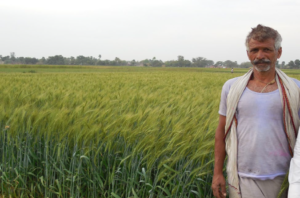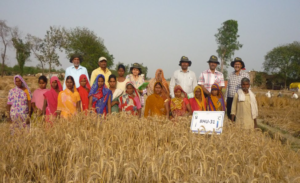INTRODUCTION
About 2 billion people around the world suffer from micronutrient deficiency, according to the World Health Organization.1 Also known as “hidden hunger,” micronutrient deficiency occurs when people eat food that does not provide enough vitamins and minerals. People living in South Asia and Sub-Saharan Africa are hardest hit by hidden hunger, which is characterized by iron-deficiency anemia, vitamin A and zinc deficiency.1 Zinc is important for cellular growth, cellular differentiation and metabolism. Zinc deficiency limits childhood growth and decreases resistance to infections. Supplements may help to improve linear growth of children under 5 years of age. Zinc deficiency affects about one-third of the global population. Severe zinc deficiency can result in short stature of preschool children and approximately 165 million children under five years of age are stunted, with the vast majority living in Africa and Asia resulting in the hypogonadism, impaired immune function, skin disorders, cognitive dysfunction, and anorexia. Wheat (Triticum aestivum L.) is a major staple crop, providing 20% of dietary energy and protein consumption worldwide.2 It is an important source of mineral micronutrients such as zinc (Zn) and iron (Fe) to the resource poor consumers.3 The breeding targets for high Zn wheat was derived based on the bioavailability of Zn enriched wheat, daily per capita intake of wheat, type of food preparation, and estimated average requirements or Recommended Daily Allowance (RDA). The preliminary breeding target for Pakistan and Northern India is to increase Zn levels by 12 mg/kg, above the baseline levels of 25 mg/kg, which is the mean of popular varieties currently grown in the region.4
Large variability for these micronutrients has been found in landraces and wild relatives of common wheat.3 A targeted breeding program was initiated at the International Maize and Wheat Improvement Center (CIMMYT) in 2006-2007 to develop wheat germplasm with 8-12 mg kg-1 increased grain Zn concentration over the popular varieties grown in the target regions along with profitable yields, and farmer preferred agronomic and end-use quality attributes.5,6 The main feature of this program is the introduction of novel genetic diversity from wild species and landraces into the adapted wheat backgrounds. The objective of the research reported in this paper is to update the varietal adoption status of high Zn wheat varieties in the target environments of Eastern Gangetic Plains of India as a case study example.
SCALING UP DEPLOYMENT OF ZN ENRICHED WHEAT
To assure nutritional and food security, it is paramount that suitable biofortified wheat varieties identified for specific growing conditions that are released and seed disseminated for their widespread adoption. Competitive high Zn wheat varieties were distributed to national program partners in South Asia to reach resource poor small-holder farmers. Superior agronomic traits are inherent in these biofortified wheat varieties along with enhanced nutritional value. Adoption of these new varieties together with improved agronomy is expected to scale up significantly with the public-private partnerships (PPP). A publicprivate partnership (PPP) is a contractual agreement between a public agency (federal, state or local) and a private sector entity. Through this agreement, skills and assets of each sector (public and private) are shared in delivering seeds of biofortified wheat to farmers.
In 2012, HarvestPlus program of the Consultative Group on International Agricultural Research (CGIAR) devised a strategy in alliance with Banaras Hindu University (BHU) and CIMMYT to reach thousands of wheat farmers with high zinc wheat in North Eastern Plain Zone (NEPZ) of India. We along with HarvestPlus identified Eastern Uttar Pradesh (UP) of NEPZ as a proof-of-concept strategy to test and promote high Zn wheat varieties. The productivity of wheat in farmers’ field in this region is comparatively low when compared to other parts of the country due to unavailability of new improved wheat varieties and low mechanization, for example. Hence, this region was chosen to replace existing disease susceptible varieties with zinc-fortified, disease resistant wheat varieties by creating awareness about nutritional and agronomic benefits of high Zn wheat varieties. After two years of multi-location testing led by BHU researchers at the university’s research stations and onfarm testing in neighboring villages of 3 districts, several leads were identified, which combined 8-14 ppm Zn advantage, competitive yielding ability and tolerance to water-stress and heat. In 2012, these biofortified wheat varieties were demonstrated to farmers through Participatory Variety Selection (PVS) approach in 18 villages falling under the districts of Mirzapur, Chandouli and Varanasi. There was a great interest among farmer’s community to adopt high Zn wheat varieties by seeing their agronomic potential and its nutritional benefit. To expedite the variety release process and a fast-track commercialization, six best leads were identified for pre-release seed multiplication, of which T.SPELTA PI348449//2*PBW343*2/KUKUNA (BHU3) and CROC_1/AE.SQUARROSA (210)//INQALAB 91*2/ KUKUNA/3/PBW343*2/KUKUNA(BHU-6) were the ‘best bets’ with high Zn and competitive agronomic benefits.7 In India, wheat can be grown only in winter season, but to expedite seed availability to meet the seed demand the crop delivery team of HarvestPlus undertook off-season seed multiplication in the Himalayan Mountains. As soon as seeds were multiplied, during 2013 season about 1000 mini-kit seed bags were distributed to progressive farmers in Eastern UP. Simultaneously, rest of the seed was used for main season multiplication led by HarvestPlus. To meet the seed demand, the ‘Sai Seeds’ company owned by a progressive farmer in that region came on board to multiply and commercialize high Zn wheat varieties as truthfully labelled seed. In 2014, more than 10,000 farmers adopted high Zn wheat through formal and informal seed systems. The Sai Seeds, in conjunction with BHU scientists, conducted several field days by inviting men and women farmers to demonstrate the agronomic and nutritional superiority.
The public-private partnership (PPP) is gaining momentum in seed sector in India. The Nirmal seeds of India joined hands with HarvestPlus for fast-track commercialization of two of the lead varieties Abhay (ZincShakthi) and Akshai (BHU3) by rigorous multi-location testing of more than 250 diverse sites and full-fledged seed production of these varieties to commercialize during 2015-2016 crop season. Astha Beej based in Uttarakhand also marketed 4 tons of ‘ZincShakthi’ seeds (produced and provided by HarvestPlus) in 2014 as “Chitra” and also multiplied its seeds in over 100 acres for marketing in 2015. In addition seed multiplication of BHU6 was undertaken by HarvestPlus in 170 acres to ensure that through the PPP more than 50,000 wheat farmers will benefit from the zinc-biofortified wheat varieties in India during 2015-2016 crop cycle.
As a follow-up action of the outreach activity, regular field visits were ensured by BHU, CIMMYT and HarvestPlus scientists to oversee seed multiplication programs in Mirzapur district of UP. The feedback from the progressive farmers in the region, was very encouraging. They were happy with the performance of ‘Zinc Shakthi’ variety for its good performance under fully irrigated and limited irrigated conditions. For instance, this variety had about 5-10% yield advantage under limited irrigated conditions over the currently grown local varieties with 40% Zn increment (Figures 1 and 2). All the farmers expressed their satisfaction about the performance of ‘ZincShakthi’ and other leads which are in seed chain. Most of the farmers ensured that they will use part of the harvested seed for their use and will also distribute to neighboring farmers. Some of the farmers also expressed their satisfaction about its grain size, cooking quality, grain color and overall appearance.
Figure 1: Biohappiness: A happy farmer grows ZincShakti wheat on his farm, Uttar Pradesh, India.

Figure 2: Women farmers involved in seed production and dissemination of high Zn varieties, along with BHU and CIMMYT researchers.

ACKNOWLEDGEMENTS
The authors grateful to funding support from HarvestPlus Challenge program and active support and cooperation from progressive farmers in the region and public-private partners involved in seed dissemination system.
CONFLICTS OF INTEREST
The authors declare that they have no conflicts of interest.
CONSENT
We have obtained written permission from the farmers in the image.







